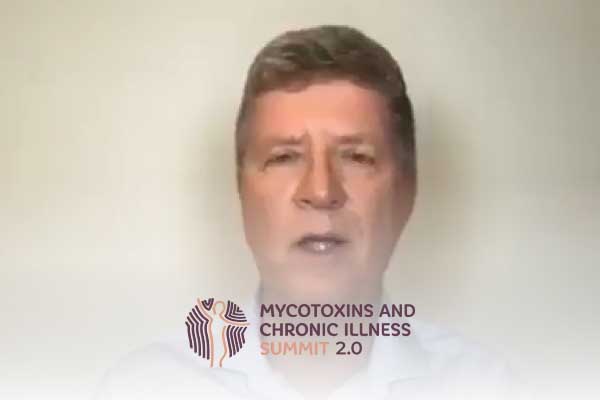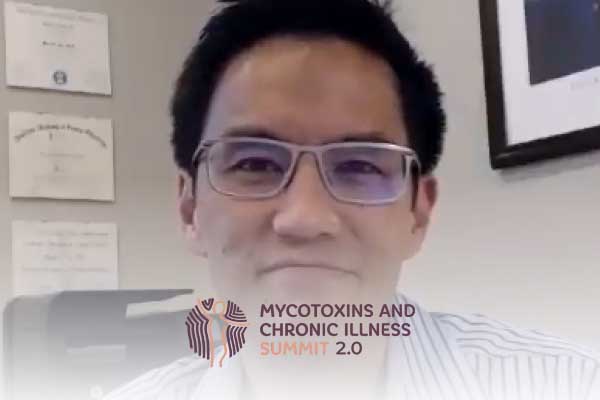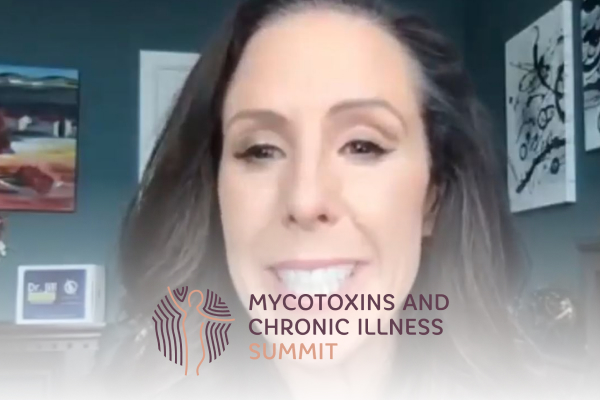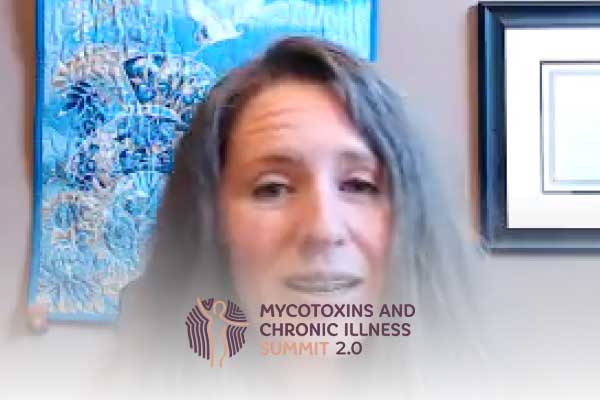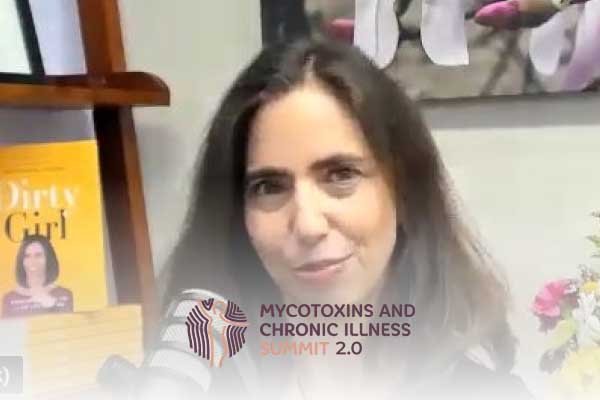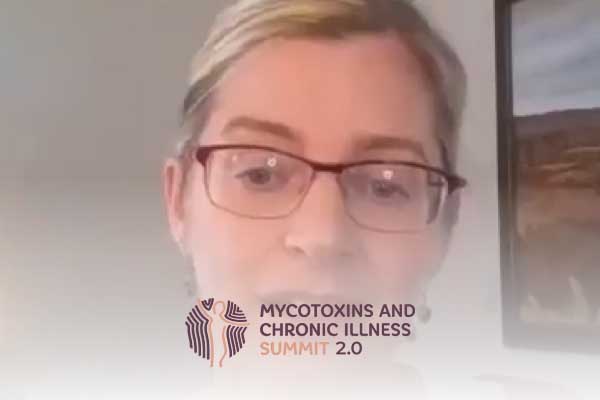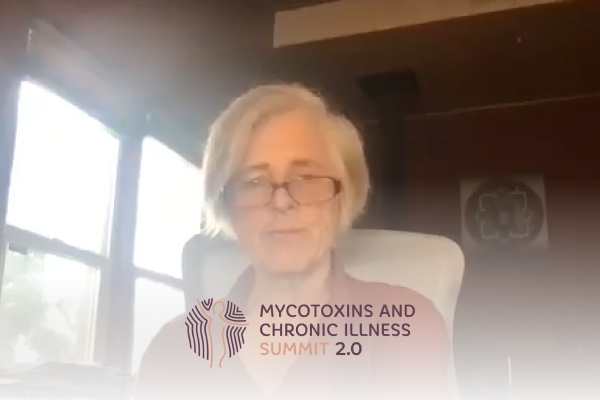Join the discussion below

Nafysa Parpia, ND has an independent practice at Gordon Medical associates, specializing in the treatment of Lyme disease and other complex chronic illnesses such as autoimmunity, mold toxicity, fibromyalgia, environmental toxicity and gastrointestinal disorders. Her patients with chronic Lyme Disease are typically those who either do not do well with antibiotics, or prefer... Read More
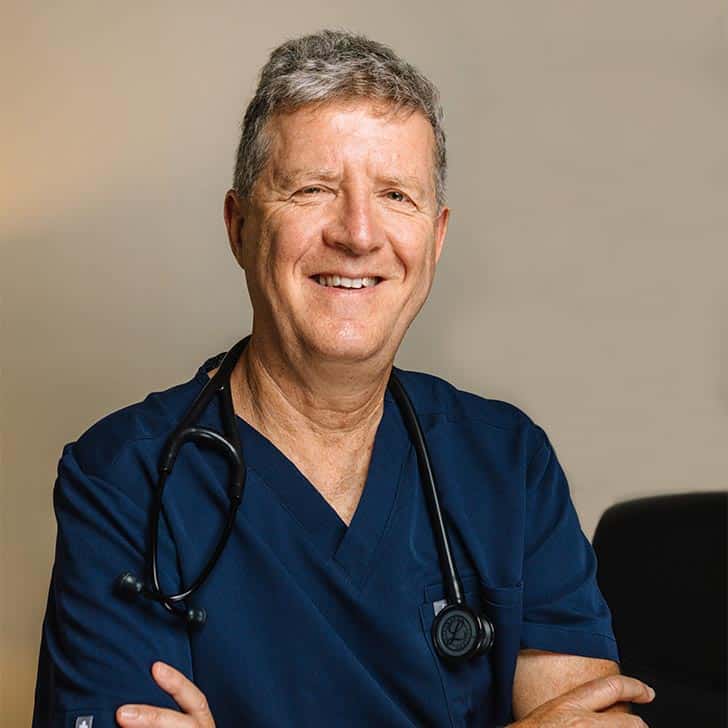
Isaac Eliaz, MD, MS, LAc has been a pioneer in the field of integrative medicine since the early 1980s, with a focus on cancer, immune health, detoxification and mind-body medicine. He is a respected formulator, clinician, researcher, author and educator, and a life-long student and practitioner of Buddhist meditation. With... Read More
- How glyphosate exposure fuels mycotoxin illness
- The role of Galectin-3 and its role in biofilms and Mycotoxins
- How to defend against glyphosate/pesticide toxicity and downstream effects
Nafysa Parpia, N.D.
Welcome to this episode of the mycotoxin and chronic illness summit. I am so pleased today to have with me Dr. Isaac Eliaz. If anybody has wondered how I became an expert in detoxification therapies, it is through this man. He is my mentor. He’s taught me everything I know about detoxification therapies. And so my practice is what it is today because of Dr. Isaac Eliaz. So, Isaac, I am just so happy to have you here today with our audience. Just such a pleasure, so welcome.
Isaac Eliaz, MD, MS, LAc
Yeah, thank you so much for your kind words and I’m rejoicing when I see how you are unfolding and, you know, through the summit and your work, you are touching so many people. And before we dive into the details, both you and I share a true holistic perspective both from our own somatic experiences, from integrating meditation and healing, from seeing a very big picture which you cannot really bind in the physical terms to going down to the biochemistry and the pathways. And when you look at mycotoxins and chronic illness, and you look at mycotoxin as a key piece with so many other pieces playing into this, you got to have the whole picture.
If you just stick with the biochemistry, with pathways, you’re gonna get stuck. You are undermining the body’s wisdoms and the things that your approach, my approach and also loving using plant medicine and using a substantive wisdomative energy. So seeing the amazing work you do, well, including the patients that we share and they see your work, really, you really did an amazing growth job. So I wanna congratulate you, really, great job Nafysa.
Nafysa Parpia, N.D.
Thank you.
Isaac Eliaz, MD, MS, LAc
Proud of you.
Nafysa Parpia, N.D.
Thank you so much. So, tell our audience what your view on detoxification from a holistic integrative perspective is.
Isaac Eliaz, MD, MS, LAc
So detoxification is really the most fundamental process in our body. We come to this world detoxifying, we take an exhalation and we cry, we let go, and we leave this world detoxifying. We take an exhalation when we leave our body. So our life is defined by detoxification, by letting go on both ends. So the letting go process is really the essence of the detoxification process. And when we try to absorb this concept, we try to understand it, we realize it has so, so many layers. And the layers start from the psychospiritual to mental, to emotional, to physical, to toxins of different kinds, if it’s heavy metals, mycotoxins, toward traumas that we had, to trauma that our ancestors had, trauma that our community had and the epigenetic effects, and it all lends itself to really understanding what is our unique individual composition and how we can change it. And I think that in my book, “The Survival Paradox,” I really introduce the basic concept that our innate inherent drive to survive, which is the body’s wisdom is really what causes us chronic illnesses. And mycotoxins fall completely within this category. Mycotoxins are attempt of mycosis kingdom of fungus to survive. They produce toxins.
Nafysa Parpia, N.D.
Right.
Isaac Eliaz, MD, MS, LAc
And so when we look at letting go and detoxification, which will be our main focus today, we’ll touch a few other topics. It’s about letting go, which is an active process but within it also finding harmony. Because if we can reduce our survival drive, if we can create a sense of balance, safety, open heart, as a whole being, all the way, not only to the cellular level, Nafysa, all the way to the mitochondria. So we can take a deep breath, we can relax. Then our metabolism becomes normal. We don’t get all the reactions, the immune dysfunctions, the inflammatory dysfunction that drives mycotoxin and chronic disease. So this is all built into the detoxification process. And each of us has a choice how deep they want to detoxify.
We do it on a daily basis every time we exhale. And it’s important to know the exhalation is twice as long as the inhalation. The exhalation is a natural movement of the lungs. So the lungs is a major detoxifying organ, a major letting go. So we do it all the time. And then we can tailor and design more intense detoxification program that can be done on as need basis based on illnesses, if somebody is mycotoxin, the detox is essentially really can’t get better without it, and combine it with more of a seasonal detoxification when we become in sync with nature. And so this is really a journey that I’ve been talking about, contemplating and teaching for decades.
And I have my own detoxification experiences because for close to 20 years, I would every year go for two months to the mountains to meditate. And sometime it wasn’t the ideal season for detoxification ’cause it was still January, February, but it was when I had time. And I would go through a major detoxification process spiritually, mentally, and in my diet, in my cleansing, you know, injections to my, hemotoxicology every day and it would be remarkable. My health post-detox would be, truly it would transform my health. So there are many, many layers. And then we have to synchronize them into the specific condition of the person, what illnesses they have, what labels they have. And then what is their constitution? What pathways are working well for them? And what is their goal? Where do they wanna come out when they finish detoxification? All of these are steps in the journey of detoxification.
Nafysa Parpia, N.D.
So you are talking about detoxification in a way that I hear very few people talk about. Most people talk about it just with diet or just with some supplements. And they’re not thinking about the whole picture. And I love that you’re bringing it up with respect to everything from ancestors, all the way down to mitochondria, everything in between. And what I think you’re telling the audience also is that it’s not so black and white. It’s not just, here, have these cruciferous vegetables, have some milk thistle and have a binder and sweat a lot. And make sure you’re not constipated. It’s so much more than that.
Isaac Eliaz, MD, MS, LAc
Right.
Nafysa Parpia, N.D.
And this is why I loved learning from you. This is why I loved being mentored by you because I’d watch you and I learned from you how to take it through personally with each and every patient, which is the part that you’re talking about. Now, can you tell us more about how you would assess an individual?
Isaac Eliaz, MD, MS, LAc
Yeah, of course. So, you know, when we look at detoxification, we have to have a plan if we talk specifically. So we have to prepare for detoxification. And the preparation is a lot on the persons and that’s when a person have to define, you know, many of us go through detox, but very seldom someone takes the time to say, what do I wanna change? What do I wanna get rid of? So, you wanna get rid of mycotoxins. You wanna get rid of heavy metals, you wanna get rid of a relationship that was devastating for you. You wanna get rid of some negative anger.
You wanna get rid of traumas. You define what you want to do. And then you need to expose. You’ve got to expose and make the body, make the site that you want to detoxify available to detoxification. And the body is smart. The body want to survive but also toxins want to survive. Also fungals want to survive, just like cancer, you know, which is really my main work, want to survive. And so one of the mechanisms that it happens is that these organisms create an isolation. And that’s the critical role of biofilm in addressing them as part of detoxification.
Nafysa Parpia, N.D.
Yeah.
Isaac Eliaz, MD, MS, LAc
So biofilms can of course happen in the gut, but the biofilm is also an atherosclerotic plaque that under it there are certain viruses or bacteria or heavy metals or a calcium plaque. And the circulation is no longer normal there. And it’s also the environment of a micro environment that the cancer cells create where they can grow because there’s hypoxia. But the hypoxic environment, Nafysa of the cancer cells is very similar to what fungals need. So there are a lot of similarities in the environment where you don’t get enough oxygen coming to the tissue because it’s kind of surrounded, it’s very dumpy. People get mycotoxin in dumpness. When example, when it’s thick, oxygen can’t penetrate as well, we’ll call it environmental hyperviscosity, but then it, of course it gets translated into our body.
And then you get a chain of events, I don’t wanna make it too complicated, that eventually will affect hypoxia inducing factor. The cell realizes it doesn’t have enough oxygen, it goes into a survival mode. It goes into glycolysis. It produces lactic acid. It gets more acidic. It gets more acidic, it activates mycotoxins. It also have something like glyphosate or pesticides dump all the toxins, where? In the damaged tissue. So we got to expose. And in order to expose, we need to know. And this is in many level. I take responsibility for creating maybe one of the biggest imbalances in our field between the research I’ve led on galectin-3 and modified citrus pectin with over 75 papers. You know, I just got a major NIH grant on my research on galectin-3 and not making it known enough.
People really need to understand there’s a protein called galectin-3, which is really the backbone and the driver of inflammation and fibrosis. And galectin-3 builds the biofilm and galectin-3 drive the myocotoxic response. If it’s in the lungs, with inflammation and fibrosis with black mold. If it’s in the brain with glial cells and gliotoxins, they all up upregulate this protein called galectin-3. So, the building block in dissolving and exposing, is using modified citrus pectin. Specifically, I wanna say PectaSol because of empowered science. It’s my work for almost 3 decades and 75 published papers. We have shown including in papers with the USDA that PectaSol is able to be a prebiotic, to inhibit negative bacteria, to inhibit different infectious agent and to promote healthy gut. So, if we can dissolve the biofilm, then we can start binding.
Nafysa Parpia, N.D.
So, are you telling us that PectaSol not only is it a binder, but it also dissolves biofilm?
Isaac Eliaz, MD, MS, LAc
Yes, that’s the key thing. I’ve been thinking about them. I talked to you and to Eric and to other experts, and somehow people put PectaSol as a binder. And I’m not saying it because of my work. There are almost 10,000 papers on galectin-3. Binders are here and PectaSol is in another universe. And why? Because PectaSol blocks galectin-3. It dissolves the abnormal inflammatory and fibrotic response. We all know when you give somebody a binder, often it will aggravate them. With MCP, with PectaSol, it reduces the cytokine storm.
We have shown in studies, in sepsis studies, we have published some major papers in last year with very good group of critical care doctors, where we have shown that levels of galectin-3 at the time when you come into the ICU with sepsis, with no kidney damage, will determine who will die later in the intensive care unit and who will get acute kidney injury. Now these are extreme example of what happens with mycotoxins. Of what happen with pesticides. We know for example, that glyphosate has a correlation with increased level of chronic kidney disease.
So, we have to understand that we got to address galectin-3, it’s the basis, no matter what programs you do, if you integrate PectaSol, you will get better results. Sometimes immediately, sometime it takes a long time. You know, we just published in a different field a multicenter trial on a biochemical recurrence of prostate cancer. And our MCP benefited close to 80 percent of the people. But even when we followed for additional 12 months, out of who benefited after six months, most of them, 80% benefited for another 12 months. But interesting, some people, it took six months until they started seeing benefits. It takes time, each of us responds differently. So the exposure in the binding together with the last element which is a balance and support regulating the immune response.
Just like in the study that I mentioned, we showed that when we gave our MCP in an animal model, in the most classical sepsis animal model, we prevented, we attenuated the spiking interleukin 6. We attenuated the nest inflammation, the kidney damage and the mortality. And now we are moving into clinical trial of course, with this. So, it’s really essential for people to understand, yeah, PectaSol is a binder but it’s not a binder. Binder is one of its properties. It really addresses the basic mechanism of how our body operates when it has an imbalance survival response. That’s why I call galectin-3, I coined it the survival protein.
Nafysa Parpia, N.D.
Right.
Isaac Eliaz, MD, MS, LAc
Well, that’s very basic because the beauty, and I wanna emphasize it is that, you are exposing, you are binding, but you’re also treating in the same time. So you don’t get the damaging inflammation and fibrosis, which is so critical in all the tissues in the body, including in the brain.
Nafysa Parpia, N.D.
Right, so, as you’re talking, I can’t help but think about COVID long haul. We’re seeing a lot of people in our clinic with COVID long haul syndrome. And of course I give all my patients PectaSol, but you know, I’m thinking about long haul and the inflammatory response that goes on. And I’d love for you to talk about how galectin-3 and PectaSol must play a role in COVID long haul.
Isaac Eliaz, MD, MS, LAc
Yeah. It plays a key role if it’s a COVID long haul from being sick or if it’s from a vaccine, it doesn’t matter what is the belief system. The symptoms are the same. So, it’s two main, main areas. The first area is that galectin-3 drives the cytokine storm. Cytokine storm is at the essence of my research. The large grant I just got from the NIH is on studying and attenuating cytokine storm in sepsis, through galectin-3. That’s my work. So, there are dozens of paper showing that galectin-3 drives interleukin 1b, interleukin 6, interleukin 10, TNF alpha, NF kappa beta. This is like putting the field on fire. And when you give our MCP, it attenuates the process. It’s really well established and by third party academic institute, really, I mean, every month there are one to 3 papers on our MCP.
Nafysa Parpia, N.D.
Can I ask you to explain to our audience how galectin-3 is created in the first place?
Isaac Eliaz, MD, MS, LAc
Of course, so, galectin-3 is a carbohydrate binding protein. It’s a protein that has a structure that binds to different ligands through the carbohydrate, through the sugar end. So this can be small oligosaccharides, but this can also be glycolipids. This can also be glycoproteins. So galectin-3 is a bus that chatels inflammatory compound, fibrotic compound, immune suppressing compounds and gross factor compound. Why? Because it is used for injury repair. How do we repair injury? Through inflammation and through fibrosis. That’s the problem. Galectin-3 is very important for the first five minutes but it never shuts down and we are showing it.
So, once it binds to an ST ligand, it creates a pentamere of five. And then these five bind to many others, either directly or through ligands. And you get a film, you get a scaffolding, you get a lattice formation. So this strong biofilm that surrounds microenvironment, you know, that Virginia Livingston was talking about decades ago. The basis of naturopathy that medicine now recognizes. It’s really, the basic structure is galectin-3 based. On top of it, phospholipids can come. Heavy metals can come because the galectin is negatively charged, it will bind to positively charged heavy metals. So it’ll bind to oxidized lipids that are binding to heavy metals. And it will drive into the inflammatory area. And then there it’ll cause this havoc. So, this is how it works. So addressing it is fundamental to healing.
Nafysa Parpia, N.D.
Right.
Isaac Eliaz, MD, MS, LAc
But if I go back into the COVID because I didn’t answer your question,
Nafysa Parpia, N.D.
Yeah.
Isaac Eliaz, MD, MS, LAc
So one thing is the attenuation of the cytokine storm. People from COVID long haul are really affected by the cytokine storm. The other thing is that the lungs have the highest number of galectin-3 receptors. So there are studies showing, large study from Mexico city, from somebody I collaborated in the past when they were in Harvard, shows that when COVID patient come to the emergency room in the largest hospital in Mexico city, regardless of how sick they are, the levels of galectin-3 will determine how sick they will get and who will die, at the time that they show up, why? Because of this survival. So we understand the cytokine but here is the big thing. And that relate to mycotoxins.
We are not the only one to survive. Mycoses want to survive. Candida want to survive, right? If we balance our microbiome, if we don’t disrupt it with unnecessary antibiotics and toxins, then there’s harmony. This same organism that could be devastating are helping us, if they’re respecting the mutual relationship in the microbiome, which is a whole topic that I write, of course a lot in the book. But the virus wants to survive and how will the virus survive? Through its spiking protein. And guess what? The spiking protein is practically identical to galectin-3. The same molecule that we use to survive is used by the virus. So when you take a galectin-3 blocker, you are reducing the inflammation but you’re also blocking a lot of the sites.
Nafysa Parpia, N.D.
The spike is similar in its physical properties to galectin-3?
Isaac Eliaz, MD, MS, LAc
The structure is similar, it’s so insane.
Nafysa Parpia, N.D.
Wow, that’s big news, Isaac.
Isaac Eliaz, MD, MS, LAc
Well, guess what? I already shared it in mid-2020. And then the papers were coming, one of the papers published. But this is part of our journey. Like the oncologist in Israel who led all the multicenters is Isaac, you know. Your name is Isaac Eliaz it’s not Isaac Pfizer, you know? So, you’re not getting the attention.
Nafysa Parpia, N.D.
Right.
Isaac Eliaz, MD, MS, LAc
But, because I try to do clinical trial. I mean, it’s a safe substance, you know. But we get the feedback from people who are using MCPs, they’re not getting sick at all. We are just not talking about it too much, we know, ’cause of the sensitivity. And we truly believe in integrative approaches and using all methods as you know. But the concept of the survival paradox is true to the virus itself. So the benefit of blocking of galectin-3 and using MCP directly for the COVID and in reducing the ongoing cytokine storm. And it can take time. Some people it’s dramatic, some people it takes time.
Nafysa Parpia, N.D.
Yeah, so tell us about the role of toxic burden when we’re looking at mycotoxin illness.
Isaac Eliaz, MD, MS, LAc
So, you know, when we look at toxic burden, we really want to look at the multiple aspects that created. So, if we are focusing here on mycotoxins and their ability to affect every tissue. And the thing is there is more and more attention given to the gut-brain connection.
Nafysa Parpia, N.D.
Right.
Isaac Eliaz, MD, MS, LAc
Because the vagal nerve has much more information going up to the brain, than the brain coming down. And you know serotonin is almost exclusively produced in the gut. So mycotoxins are very devastating but they get activated. They get activated by heavy metals. Mercury is the classical one and lead, but they really get activated by pesticides. I told you Nafysa, we’ve been talking about it. It’s an area that I kind of knew. And I mean, PectaSol does remove mycotoxin driven compound. Like it removed the CCl4, was published already in 2000 in JNCI formal place, is Journal of National Cancer Institute. I think it was a journal out of a big paper. So we all know, yeah, they are pesticides but I didn’t take enough of an active role in finding a solution. It’s kind of almost like you accept that you can’t get away from it, you know? But as I’m looking at it deeper in the last two years, and especially the last year, it’s blowing my mind. I mean, what’s happening with glyphosate, which actually I’ve been talking for quite a few years, but it’s really criminal, you know? I mean, and for people who are listening, watching, I mean, it’s logical, whatever’s gonna kill something is not gonna be good for us.
Nafysa Parpia, N.D.
Exactly, right.
Isaac Eliaz, MD, MS, LAc
But glyphosate is very nasty, not only on its own, but how it potentiate mycotoxins. How it increases the production of mycotoxins. How it helps them to create more damage. And when we look at glyphosate, it’s not only glyphosate. There are thousands of glyphosate from ulations quote-unquote, where other toxic stuff is put with them. So, we talk a lot about glyphosate, but it’s not the only herbicide or pesticide of course. But it’s really, really, really, it’s a real problematic area that needs to be addressed as you know, I’ve put a lot of work into addressing it. And PectaSol is a great adjuvant for it but I created a product called Glypho Detox, where we are getting great feedback from patient, but we are also engaged in clinical trials because it’s important to create scientific and published literature. And I’m addressing it very much from the perspective of what we discussed, from an holistic approach.
And I think that for people with mycotoxins, you got to address a pesticide on an ongoing basis. And the reason why it’s an ongoing basis, is that we can’t avoid it. I mean, if you look at the literature, in certain foods, United States is 10 to 100 times more pesticide of life than in Europe. And the important thing that a lot of us know, is that for example, people who are gluten sensitive, who go, who travel to Italy, for example, they say they can’t eat breads, they can eat pasta. And we always used to say right, Nafysa, it’s a GMO, it’s a GMO. But the GMO is secondary. The GMO allows mycotoxins to grow because of the glyphosate and the GMO contains glyphosates. And it’s the glyphosates that create damage in the permeability of the gut, leaky gut. It weakens the tight junctions. It allows antigens to penetrate into the system and it will create gluten sensitivity. I’m really glad that I created the Glypho Detox and I think it’s gonna be a game changer for a lot of patients.
Nafysa Parpia, N.D.
So tell us what is in Glypho Detox and why it works.
Isaac Eliaz, MD, MS, LAc
So, Glypho Detox, again, addresses the issue from, start from a very holistic approach. I truly believe, and I think it’s our experience, I think you have the same experience, that in every kingdom, when there is a problem, there is a solution. So, if you look at pesticides, they affect our plants. They affect our earth and they affect our waters, our oceans. So, I derive solutions from all these places. I’m using specialized pectins, it’s not MCP. MCP will have a systemic effect. I’m using a high molecular pectin that will stain the gut and will bind not only pesticides but also lipid-soluble toxins, including mycotoxins, it is published. And so I’m using pectin as one compound that addresses the plant.
Of course, meats come from, animals eat plants. Then from the water kingdom, we are addressing alginates, which have a great profile of binding of toxins and both mycotoxins and pesticides and then using kelp. There are studies on kelp being able to neutralize and bind glyphosate, actually from 2021. But the beauty of kelp, is that it’s food. It has this wisdom of cleaning and providing nutrients. Now this is why they’re so fascinating. Because glyphosate is not just toxic, it’s a nesticillator of mineral and amino acids for example.
Glyphosate will bind to tryptophan and tryptophan will not allow lactobacillus to function normally, creating these bioses, mycoses and increasing mycotoxin. Glyphosate will stimulate and bind to glutamate receptor because it’s so similar to glycine, will create an excitatory effect in the brain and narrow inflammation. And then you got anti-glial mycotoxin coming into the brain. And then you got with all of these, the galactin-3. For example in Alzheimer plaques, galectin-3 is present in 20 times the concentration compared to normal.
Nafysa Parpia, N.D.
Wow, that’s a lot, yeah
Isaac Eliaz, MD, MS, LAc
Because it’s so inflamed. But remember, galectin-3 also stimulate mycotoxins. You can see the connection. All coming from this understanding of the survival paradox. So this is a very important ingredient. And then from the earth, the earth is very wise. So the earth created something that, you know, in traditional ayurvedic medicine, shilajit. Shilajit is a fermented compound of what really penetrates in the Himalayan through thousands of feet until they collect it. And it’s rich in minerals and it is an immune enhancer. It normalizes mitochondrial function but it contains fulvic acid, which is able to bind to glyphosate, but also stabilize the tight junctions in the gut.
So, you can see all the compound and then I have to add an engine, something that will move the formula. And this is glycine because glycine is such an important neurotransmitter, a detox component, and it’ll help in the detoxification of the liver. It’s necessary for normal function of glutathione. And some of the researchers of glyphosate, like Dr. Stephanie Sen, strongly believe that because of the repeat motive of glycine, that it really exchanges with glyphosate and create disruption in different proteins and definitely glyphosate can bind to aluminum. They go, they penetrate, get neutralized. It penetrate into the brain barrier, pH changes. It dumps aluminum and glyphosate in the brain. We know the connection between aluminum and Alzheimer. And aluminum is actually removed well by PectaSol. We have published quite a new, in new papers actually we did discuss on the ability of PectaSol to quilate heavy metal. It’s well documented.
Nafysa Parpia, N.D.
It’s very exciting to get a look inside your mind. I feel like I’m asked to like, opening up your mind, taking a look and sharing it with our audience because this is the mind of a formulator that’s top notch. A lot of people formulate but they don’t do research behind it, or a lot of people formulate but they’re not taking in all of the elements around them. And they’re not taking in the research at the same time and the biochemistry. Maybe they take in one aspect of it but it’s so thoughtful the way you create your supplements. Just everything that goes behind it, from thought on the spirit level to biochemical research. Getting NIH grants. So this is very, very exciting.
Isaac Eliaz, MD, MS, LAc
Yeah, and you know, I have a really good research team that supports me but I wanna emphasize it’s the beginning of the process is insightful. If you drive your process based on logical information, you’re gonna be limited. You gotta forget, you gotta go through the non-conceptual clear space for a meditation, not non-conceptual disconnect space.
Nafysa Parpia, N.D.
Right.
Isaac Eliaz, MD, MS, LAc
And when you open up, you connect to a certain quality of understanding of wisdom that is not ours. It’s out there, we just have to connect. That’s how you do when you work with people, I’ve seen it. And I mean, we did some craniosacral on patients for hands, you know?
Nafysa Parpia, N.D.
Yes, so cool.
Isaac Eliaz, MD, MS, LAc
So, and then you fill the gaps with the research and then it really clicks. Nafysa you know how big we were on doing sinus injections, right?
Nafysa Parpia, N.D.
Yes, yeah.
Isaac Eliaz, MD, MS, LAc
And we saw that people, we would see, hold emotions, hold traumas and chronic sinusitis. We could see it until we address the sinus, the gut would just not get better, right?
Nafysa Parpia, N.D.
Right
Isaac Eliaz, MD, MS, LAc
You remember.
Nafysa Parpia, N.D.
Exactly.
Isaac Eliaz, MD, MS, LAc
You know it. And we connect to the channels but really, we know now that the sinuses of biofilm that produce mycotoxins all the time, even if it’s not visible that there is a fungal infection. So when we are using procaine with homeopathics, what are we doing? We are taking a tight survival grasp, trauma, whatever it is, it can be an infection, a trauma, heavy metal, and we are releasing it, right? Why would it happen, right? And then when we release it, the body forgets the trauma. It’s very similar to what you do when you dissolve the galectin-3. And then what we do for certain people, we’ll put ozone because now that everything is opened,
Nafysa Parpia, N.D.
Yeah.
Isaac Eliaz, MD, MS, LAc
Then the ozone can go and just create a new environment. You do just ozone, it’s not gonna work the same. You got to create. So part of our healing process is letting go of habitual patterns, you know, of habitual memories. It’s like we have to recreate our memory because our memories, our responses are survival based. And when we numb an area, we forget it. I mean, we see it with scouts of course, you know, that you do so much and I do. It kind of insane how they go and whatever we achieve never comes back. But in the sinuses, something similar happens. What we are holding, let’s go. And that’s why it’s almost universally much more effective than antibiotics, antifungals or whatever we use.
Nafysa Parpia, N.D.
Right, right. And then from a biochemical point of view, a lot of inflammation gets created in the sinuses that can cross the blood-brain barrier.
Isaac Eliaz, MD, MS, LAc
Totally.
Nafysa Parpia, N.D.
Then we’ve got inflammation crossing up this way via the olfactory nerve and through the cribriform plate. Then we can swallow that inflammation. It goes down into the gut and so…
Isaac Eliaz, MD, MS, LAc
Completely correct.
Nafysa Parpia, N.D.
Yeah.
Isaac Eliaz, MD, MS, LAc
I know we’re talking about going up, up, I mean, the pituitary is right there, you know?
Nafysa Parpia, N.D.
Right.
Isaac Eliaz, MD, MS, LAc
So right away, you mess all your endocrine system and in so many levels, you know? If we do craniosacral, if we go more of the gentle way and we just open and create space, so the contraction is… and then we know when we do it before, after. So this is an example that you and me are chatting in public about, like,
Nafysa Parpia, N.D.
Right.
Isaac Eliaz, MD, MS, LAc
What we do with patients but it’s the same principle for patients. So, if you were to ask me, Isaac, can you give one really important advice to mycotoxin patients. To patients with chronic symptoms, you know, to patients with mass cell activation, which often it’s similar group.
Nafysa Parpia, N.D.
Right.
Isaac Eliaz, MD, MS, LAc
I’ll say, try not to identify with your symptom. So what do I mean? You know, you feel well and suddenly you get a headache. And you know that usually when you get a headache, afterwards you get this symptom and that symptom and that symptom. So that happened to you like 50 times. So you are naturally on the same path. It’s a neurological path. That if now the headache is come, everything else is gonna come. And you react early, already expecting something to happen. But if you can just see, right now I have a headache. A moment ago I didn’t have a headache and a moment from now, I may not have a headache again. If we can disconnect this habitual pathway. And that is the core of freeing the survival paradox.
I do this a lot working when I teach meditation in healing, which I teach mainly in Hebrew, in Israel, but I will teach more in the United States with my book. That’s part of the detox of the mycotoxin because mycotoxins live in a sticky environment in a dump environment, right? Like dump house syndrome, it’s all the same environment. This stickiness is also stickiness that affects our mind. And we want to dissolve the stickiness. So we dissolve it meditation wise, understanding wise, dealing with our scars of survival, through what we talked with scar injection, through the sinuses, a must through dissolving the biofilm, through using modified citrus pectin. And Nafysa you can understand, wow, Isaac, how comes there was a paper on acute kidney injury with galectin-3 and MCP and then on NASH and then on pulmonary fibrosis and then there’s on cancer. Because it’s driven by a very basic process, it takes different highways.
And each highway will lead to a different disease. So that’s a process that the person can really work, is catch yourself when the stickiness of the mycotoxin is about to take you down a path, which is very useful for the fungals. They love it when you are anaerobic. They love it when you don’t breathe. They love it when there is no oxygen, when you can’t clean up the mess. If you can just catch, take a deep breath. It can really, really shift the process. And the shift of the process is biochemical, it’s cellular, it’s emotional and from a cellular perspective, it starts in the mitochondria. And fungals, mycotoxins are known unnasty modifiers of normal cellular function and a normal mitochondrial function.
And we need to address it from using compounds like honokiol that balances mitochondrial function to using modified citrus pectin, to using adaptogenic herbs, to adding different nutrients. But, as I’ve been thinking about it, you know, there’s a lot of interest in methylation and specific pathways which are very important. But when we are diagnosing what pathway is problematic and relying on giving people stuff for the specific pathway, we are undermining the wisdom of the body.
Nafysa Parpia, N.D.
Right.
Isaac Eliaz, MD, MS, LAc
When we give people more of a choice, we know how to survive. We just have to pick a pattern that is survival through harmony, through open heart. And so the essence of detoxifying from the mycotoxins is realizing that this body has tens of trillions of cells. Not millions, not billions, trillions. And each cell has close to a million reactions every second. And we function in harmony, right? It’s a miracle, the fact that we can talk now is nothing less than a miracle, if you think about it. And then we got this argument, 50 trillion, 100 trillion of organisms in our gut, including a lot of fungi and parasites and everything. And they work side by side with us, they support us. If you take, immunotherapy in cancer needs a healthy gut.
When the microbiome is not healthy, immunotherapy doesn’t work in cancer. When you take antibiotics, when you take adriamycin, the most common chemotherapy, it won’t work as well. There’s this crazy wisdom when we support each other. We come to harmony. When we lose our harmony, when we go into a survival mode, that’s when our problem start. But we are built to address it. Otherwise we won’t be talking now. How do we address it? Through our heart. Because our heart is the only organ in the body that strives, thrive, that survives on what other organs call toxins. Every cell takes nourishment and throw out what it doesn’t want.
The heart takes dirty blood. It has to take dirty blood to survive. It takes what other people don’t want. It connects to the universe through the breath. Endless amount of oxygen, endless amount of energy, endless infinite healing power. That’s why we need to respect our environment, to have a good internal environment. Then the heart gives without judgment. And the heart is the only organ that nourishes itself only after it finished its work. The blood supply for the heart. So the first organ the heart supply is itself through the coronary arteries, but just after it contracted. It’s interesting, all other organs have their arteries coming earlier on, not the heart. It does it once it is done its selfless work, which is the survival of the heart.
Nafysa Parpia, N.D.
Right.
Isaac Eliaz, MD, MS, LAc
So, when we connect with our heart, then things that create triggering emotions for us, start melting away. And it holds for five minutes, for 10 minutes. We all go, right, we have a great day, we have a bad day, but we all have the ability to connect with the transformative power of the heart. And then we get blood to the tissue, we get nourishment, well as toxic. The electromagnetic field of the heart is big enough. It reaches every cell in our body all the time, including people around us. So at the basis of detoxification, especially for mycotoxin where we identified a bad thing we wanna get rid of, is connecting also with our heart. And guess what? Galectin-3 does its greatest damage in heart failure. And on which kind of heart failure? Ejection preserved. The heart failure where the heart doesn’t become too big, but it becomes stiff. It becomes rigid. It loses its ability to give. It isolates itself. It doesn’t realize that it’s part of a bigger picture. Very interesting how it works. You can see the analogies between.
Nafysa Parpia, N.D.
Right, right. I love the way that you’re bringing in medicine, biochemical medicine with Chinese medicine perspective, with healing perspective, spirit medicine perspective and looking at how those two places mirror each other. One without the other is really lacking. It’s another rare thing to see in practitioners today.
Isaac Eliaz, MD, MS, LAc
I really know the feedback I’m getting from my book, “The Survival Paradox” is really good, including from a lot of doctors in the field of mycotoxins and chemical sensitivity and mass cell activation. So, it’s really, my first book in my sixties, but in it are decades of learning and experience, so…
Nafysa Parpia, N.D.
Beautiful, it’s a fantastic book, fantastic. I just have one more question for you.
Isaac Eliaz, MD, MS, LAc
Of course.
Nafysa Parpia, N.D.
It might take a little bit longer but I’ve been burning to ask you, it’s about mycotoxins in cancer. Isaac, how do you see mycotoxin illness in cancer?
Isaac Eliaz, MD, MS, LAc
So, mycotoxins are big drivers of cancer. Big drivers because of the inflammation and because of the cellular damage and because of some direct relationship between mycotoxins and cancer and certain infectious agents. So it’s definitely part of the same package also because the abnormal metabolic changes are very similar. And in this sense, the one topic that you just brought to my mind, which I didn’t touch but this is an opportunity, is that sometimes we need help in clearing mycotoxins, especially because they are lipid-soluble. They are hidden in tissues, okay? And in this sense we talked about the heart, about letting the blood flow about. So in this sense, something that I use, that I’m kind of being what is called in the innovative field, a disruptor, is a field of therapeutic of apheresis, where I am able to clear a lot of mycotoxin, lipid-soluble toxins through therapeutic apheresis, which is a unique procedure I specialized for many years in one of the largest centers in the country. And while classically it’s used for genetic hypercholesterolemia, where people get heart attacks in their thirties, it has been especially effective for me for the severe mycotoxin cases. For the severe mass cell activation patients, where they just cannot tolerate anything.
Nafysa Parpia, N.D.
Yeah.
Isaac Eliaz, MD, MS, LAc
Because we are cleaning them outside their body. And within the process, I will give specific IVs that will help the lipid, the fat tissue, the phospholipid, fat-soluble toxins to really let go. And so, it’s a high-tech process but for patients where it’s really a mycotoxin issue, it’s often a game changer and sometimes surprisingly, relatively quickly.
Nafysa Parpia, N.D.
That’s wonderful. Thank you.
Isaac Eliaz, MD, MS, LAc
Thank you so much.
Nafysa Parpia, N.D.
Thank you. Tell our audience where your clinic is, so if they wanna come to you for apheresis or cancer therapy, how can they find you?
Isaac Eliaz, MD, MS, LAc
Right, so our clinic name is Amitabha, A- M-I-T-A-B-H-A, Amitabha Medical Clinic in Santa Rosa. And you can also find dreliaz.org and the survivalparadox.org, where it’s about my book and yeah, I hope that my work and experience, I’m now at a stage in my life when it’s about sharing the decades of studies just with others, that’s really my focus right now.
Nafysa Parpia, N.D.
Fantastic, thank you so much. Thank you for being here.
Isaac Eliaz, MD, MS, LAc
Thank you, Nafysa, it’s great to talk to you.
Nafysa Parpia, N.D.
Thank you.
Downloads

